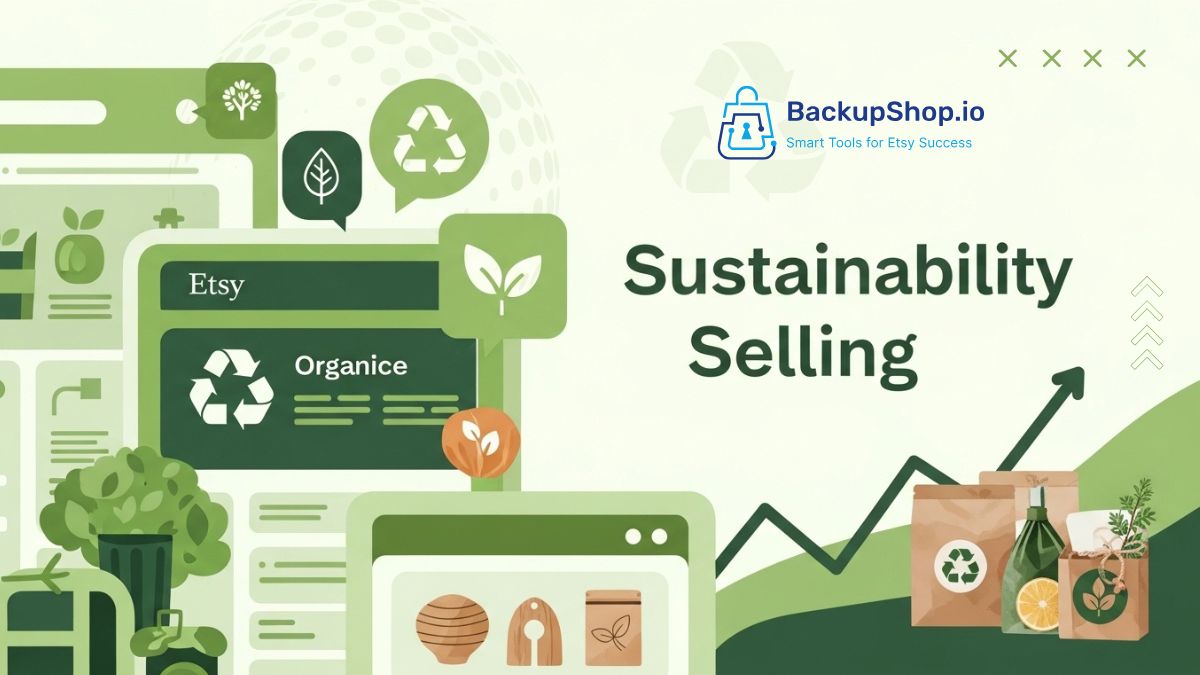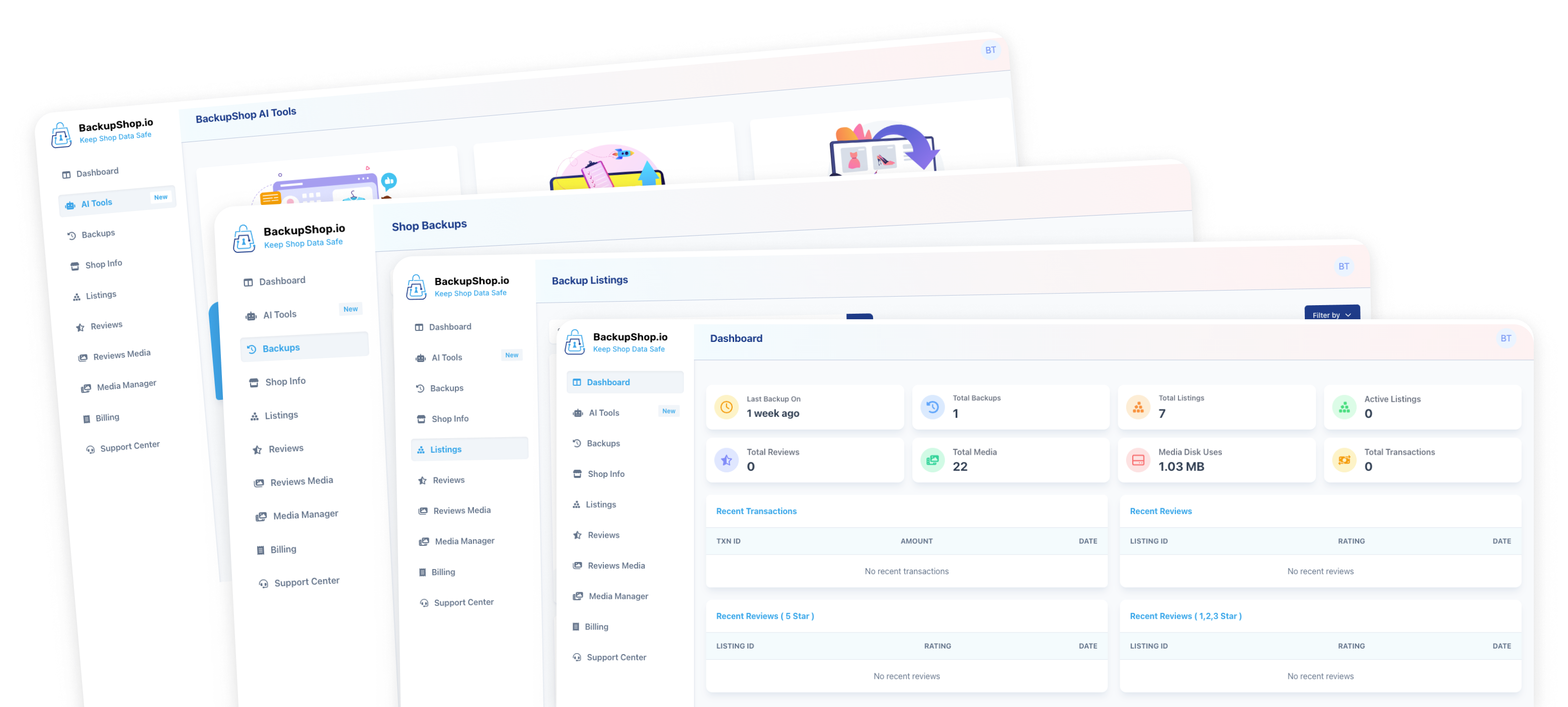Sustainability Selling: How Green Practices Are Reshaping Etsy Success

The sustainability revolution isn't just changing how we shop—it's fundamentally transforming how successful Etsy sellers operate their businesses. As environmental consciousness reaches new heights in 2025, sustainable practices have evolved from a nice-to-have differentiator to an essential component of Etsy success. Today's eco-conscious consumers are actively seeking out sellers who align with their environmental values, creating unprecedented opportunities for those who embrace green business practices.
The Environmental Trend Reshaping E-commerce
Consumer Behavior Shifts in 2025
Recent studies show that 73% of global consumers are willing to pay more for sustainable products, with this number jumping to 85% among Gen Z and millennial shoppers—Etsy's core demographic. This isn't just about environmental concern; it's about values-based purchasing that extends to every aspect of the buying decision.
The sustainability trend on Etsy manifests in several key areas:
Material Sourcing Consciousness: Buyers are scrutinizing the origins of materials, favoring recycled, upcycled, organic, and locally-sourced components. Sellers who can tell compelling stories about their material choices are seeing significant competitive advantages.
Packaging Revolution: The demand for plastic-free, biodegradable, and minimal packaging has created new market segments. Innovative packaging solutions are becoming selling points in themselves, with some buyers choosing products primarily based on sustainable packaging practices.
Carbon Footprint Awareness: Customers are increasingly considering the environmental impact of shipping and production. Local sourcing, carbon-neutral shipping options, and transparent production processes are becoming key differentiators.
Longevity Over Trends: There's a marked shift toward purchasing fewer, higher-quality items that last longer rather than trendy pieces with short lifespans. This trend particularly benefits artisans and makers who emphasize craftsmanship and durability.
The Economic Impact of Going Green
Sustainable Etsy sellers are reporting average increases of 40-60% in sales conversion rates compared to traditional listings. More importantly, eco-conscious customers tend to become loyal repeat buyers, with sustainable sellers seeing 2.3x higher customer lifetime value.
The premium pricing power of sustainable products allows for healthier profit margins. Customers understand that ethical sourcing and eco-friendly practices often come with higher costs, and they're willing to pay for the value alignment.
Building Your Sustainable Etsy Brand
Authentic Sustainability vs. Greenwashing
The Etsy community is particularly savvy about authentic sustainability versus superficial green marketing. Successful sustainable sellers focus on genuine practices rather than buzzword-heavy descriptions. This means:
Transparency in Process: Share your actual sustainable practices, challenges you face, and improvements you're making. Customers appreciate honesty about the journey rather than claims of perfection.
Specific Claims: Instead of vague terms like "eco-friendly," provide specific information: "Made from 90% post-consumer recycled cotton" or "Packaging uses water-based inks and forest-certified cardboard."
Continuous Improvement: Frame sustainability as an ongoing commitment rather than a destination. Share updates about new sustainable practices you're implementing.
Material Innovation and Sourcing
Successful sustainable sellers are getting creative with their material choices:
Upcycled Materials: Transforming discarded items into beautiful, functional products. Vintage fabric sellers, reclaimed wood artisans, and electronic waste artists are finding particular success.
Local Sourcing Networks: Building relationships with local suppliers reduces transportation emissions while supporting regional economies. Many sellers are documenting these partnerships as part of their brand story.
Alternative Materials: Experimenting with innovative eco-friendly materials like cork leather, bamboo fibers, hemp-based products, and bio-based plastics.
Seasonal and Natural Materials: Using materials that align with natural cycles, such as seasonal flowers for natural dyes or locally-harvested wood.
SEO Strategies for Sustainable Etsy Success
Optimizing for "Sustainable Etsy" Searches
The keyword "sustainable Etsy" has seen a 340% increase in search volume over the past year. To capture this traffic:
Primary Keywords: Integrate terms like "sustainable," "eco-friendly," "zero waste," "organic," "recycled," and "upcycled" naturally into your titles and descriptions.
Long-tail Sustainability Keywords: Target specific phrases like "plastic-free jewelry," "organic cotton baby clothes," "reclaimed wood furniture," or "zero waste kitchen items."
Material-Specific Terms: Include specific sustainable material names in your keywords: "bamboo," "hemp," "cork," "recycled sterling silver," "organic wool."
"Eco-Friendly Selling" Content Strategy
Beyond product listings, content marketing around eco-friendly selling practices can drive significant traffic:
Educational Content: Create listings or shop sections that educate customers about sustainable materials, production processes, or environmental benefits.
Process Documentation: Share behind-the-scenes content showing your sustainable practices in action. This builds trust and provides keyword-rich content for search engines.
Impact Messaging: Quantify the positive environmental impact of purchasing your products when possible: "Saves X pounds of waste from landfills" or "Reduces carbon footprint by Y%."
Documentation and Certification Tracking for Credibility
Essential Certifications for Etsy Sellers
While not all sustainable sellers need formal certifications, having proper documentation can significantly boost credibility and sales:
Organic Certifications: For textile and food-related products, organic certifications provide third-party validation of sustainable practices.
Fair Trade Documentation: If applicable, Fair Trade certifications can command premium pricing and appeal to socially conscious consumers.
Forest Stewardship Council (FSC): For wood and paper products, FSC certification ensures responsible forest management.
GREENGUARD Certification: For furniture and home goods, this certification indicates low chemical emissions.
Cradle to Cradle Certified: An emerging certification that evaluates products across multiple sustainability criteria.
Creating Your Documentation System
Proper documentation serves multiple purposes: building customer trust, protecting your business, and providing content for marketing:
Supplier Documentation: Maintain records of your suppliers' sustainable practices, certifications, and sourcing information. This creates transparency and helps with customer inquiries.
Process Documentation: Keep detailed records of your sustainable production processes. This information becomes valuable for marketing content and helps maintain consistency.
Impact Tracking: Document the environmental benefits of your practices where possible. This might include waste reduction metrics, energy usage, or carbon footprint calculations.
Customer Feedback: Track customer responses to your sustainability initiatives. Positive feedback becomes powerful testimonial content.
Digital Organization and Backup Strategies
As your sustainable business grows, protecting your documentation becomes crucial. Your sustainability credentials, supplier information, certifications, and process documentation represent significant business value that needs protection.
Consider implementing automated backup solutions that can safeguard:
-
Certification documents and renewal dates
-
Supplier contact information and agreements
-
Customer testimonials about your sustainable practices
-
Process documentation and improvement tracking
-
Environmental impact data and calculations
This documentation not only protects your business but also provides rich content for SEO optimization and marketing campaigns.
Marketing Your Sustainable Practices
Visual Storytelling for Sustainability
Sustainable selling on Etsy is as much about storytelling as it is about the products themselves:
Process Photography: Show your sustainable materials in their raw form, your workspace using eco-friendly tools, and the transformation process.
Before/After Documentation: For upcycled items, showing the transformation journey creates compelling visual narratives.
Impact Visualization: Use infographics or simple visuals to communicate environmental benefits.
Behind-the-Scenes Content: Share your sustainable practices, challenges overcome, and improvements made.
Building Community Around Sustainability
Successful sustainable sellers often build communities rather than just customer bases:
Educational Approach: Share knowledge about sustainable living, material choices, and environmental impact.
Collaboration with Other Sellers: Partner with other sustainable Etsy sellers for cross-promotion and community building.
Customer Involvement: Engage customers in your sustainability journey, asking for feedback and suggestions.
Transparency in Challenges: Share the difficulties of maintaining sustainable practices, making your brand more relatable and authentic.
Overcoming Common Sustainability Challenges
Cost Management
Sustainable materials and practices often come with higher upfront costs. Successful sellers manage this through:
Premium Positioning: Position products as premium offerings that justify higher prices through quality and values alignment.
Efficiency Improvements: Find ways to reduce waste and increase efficiency in production processes.
Volume Purchasing: Build relationships with sustainable suppliers for bulk purchasing advantages.
Customer Education: Help customers understand the value proposition of sustainable products.
Supply Chain Complexity
Building sustainable supply chains can be challenging, but the effort pays off:
Local Partnerships: Develop relationships with local suppliers to reduce transportation impact and build community connections.
Supplier Vetting: Invest time in researching and vetting suppliers' sustainability practices.
Backup Planning: Maintain relationships with multiple sustainable suppliers to ensure business continuity.
Documentation Systems: Keep detailed records of supply chain decisions and impacts.
Measuring and Communicating Impact
Key Metrics for Sustainable Sellers
Track metrics that matter to both your business and your customers:
Environmental Impact: Waste reduction, energy usage, carbon footprint reduction, materials saved from landfills.
Business Performance: Sales growth, customer retention rates, average order value, profit margins.
Customer Satisfaction: Reviews mentioning sustainability, repeat purchase rates, referral generation.
Process Improvements: Efficiency gains, cost reductions through sustainable practices, time savings.
Transparent Reporting
Share your impact data with customers in meaningful ways:
Annual Impact Reports: Create simple, visual reports showing your environmental and business impact.
Regular Updates: Share ongoing improvements and challenges in your shop announcements or social media.
Product-Specific Data: When possible, provide impact information for individual products.
Community Impact: Highlight how your practices benefit the broader community or environment.
Future Trends in Sustainable Selling
Emerging Opportunities
The sustainability trend is evolving rapidly, creating new opportunities for forward-thinking sellers:
Circular Economy Products: Items designed for complete recyclability or biodegradability at end-of-life.
Carbon-Negative Products: Products that actually remove carbon from the atmosphere during production or use.
Repair and Refurbishment Services: Services that extend product life rather than creating new items.
Educational Products: Items that help customers live more sustainably in their daily lives.
Technology Integration
Technology is making sustainable practices more accessible and verifiable:
Blockchain Verification: Emerging systems for verifying supply chain sustainability claims.
Carbon Tracking Tools: Apps and systems that help calculate and offset carbon footprints.
Material Innovation: New sustainable materials being developed that offer superior properties.
Automation for Efficiency: Tools that help optimize resources and reduce waste in production.
Building Long-Term Sustainable Success
Beyond Environmental Benefits
Sustainable practices often lead to broader business benefits:
Operational Efficiency: Reducing waste and optimizing resources often improves profitability.
Brand Differentiation: Authentic sustainability creates strong brand positioning in competitive markets.
Customer Loyalty: Values-aligned customers tend to be more loyal and forgiving of minor issues.
Innovation Driver: Sustainability constraints often lead to creative solutions and product innovations.
Planning for Growth
As sustainable sellers scale their businesses:
Maintain Authenticity: Ensure that growth doesn't compromise the authentic sustainable practices that built the brand.
Supply Chain Scaling: Develop relationships with suppliers who can scale sustainable practices with your growth.
Team Education: If hiring help, ensure team members understand and can communicate your sustainability values.
Continuous Improvement: Treat sustainability as an ongoing journey rather than a destination.
Conclusion: The Sustainable Advantage
Sustainability isn't just a trend—it's a fundamental shift in how conscious consumers make purchasing decisions. Etsy sellers who embrace authentic sustainable practices are positioning themselves for long-term success in an increasingly environmentally conscious marketplace.
The key to sustainable selling success lies in authenticity, transparency, and continuous improvement. Customers can detect genuine commitment to sustainability versus superficial green marketing. Focus on real practices, document your journey, and communicate your impact honestly.
As you build your sustainable Etsy business, remember that your environmental practices, documentation, and impact data represent valuable business assets that need protection. Implementing systems to safeguard this information ensures that your sustainable success story continues to grow.
The future belongs to sellers who can create beautiful, functional products while contributing to a healthier planet. Start your sustainable selling journey today, and join the growing community of Etsy sellers who are proving that business success and environmental responsibility go hand in hand.
